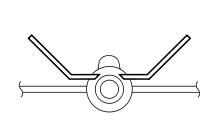Pelikan tail

The Pelikan tail is an experimental tail design for fighter jets. Originally conceived by Ralph Pelikan,[1] who was hired by McDonnell Aircraft, later worked for McDonnell Douglas and after another merger, retired from Boeing. His design has not to date been incorporated into any publicly available jets. However, it has been considered or included in design specifications in the original Boeing X-32 fighter design.[2]
Advantages and disadvantages
The Pelikan design differs from the traditional elevator-and-rudder design in that it uses only two control surfaces in order to achieve control of pitch, yaw, and roll. When evaluated by Boeing engineers in October 1998, they found advantages of greater pitch control at high angles of attack and that two tails would have a lower radar signature than four.[1][2] However, they also found that using two larger control surfaces instead of four, might actually make the aircraft heavier. The bigger hydraulic pumps and cylinders needed to operate the larger surfaces would add 800 to 900 pounds (360 to 410 kg) of weight to the design.[1] This, and other factors made them use a four-post tail instead.[1]
Tests by Virginia Tech students
Virginia Tech students built a Pelikan tail model and got positive results for its viability using a wind tunnel.[3] The analysis by the students found several advantages such as a lower vertical surface area, which aids in stealth; less drag due to skin friction; and a lower weight due to the need for two as opposed to the usual four hydraulic actuators.[4]
See also
References
- 1 2 3 4 Evan Hadingham (2003-01-01). "Winner Take All (All the nail biting, second guessing, and sheer engineering brilliance in the battle to build the better Joint Strike Fighter.)". Air & Space magazine. Smithsonian Institution: 2&3. Retrieved 2008-05-05.
- 1 2 "Nova Transcript: Battle of the X-Planes". PBS. 2003-02-02. Retrieved 2008-05-21.
- ↑ Paper on the 42nd AIAA Aerospace Sciences Meeting and Exhibit explaining the construction of a Pelikan tail model Archived 2006-10-14 at the Wayback Machine.
- ↑ Virginia Tech on building An Unmanned Combat Air Vehicle for the Navy Archived 2013-03-17 at the Wayback Machine. (explains technical details of the Pelikan tail)
